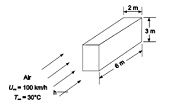Discuss the below in detail:
Q: The air conditioning system in a new Chevrolet Van for use in desert climates is to be sized. The system is to maintain an interior temperature of 20°C when the van travels at 100 km/h through dry air at 30°C at night. If the top of the van can be idealized as a flat plate 6 m long and 2 m wide, and the sides as flat plates 3 m tall and 6 m long, estimate the rate of which heat must be removed from the interior to maintain the specified comfort conditions. Assume the heat transfer coefficient on the inside of the van wall is 10 W/(m2 K).
GIVEN
A Chevrolet van traveling through dry air
Interior van temperature (Ti) = 20°C
Velocity (U∞) = 100 km/h
Air temperature (T∞) = 30°C
Top dimensions = 6 m long, 2 m wide
Side dimensions = 6 m long, 3 m wide
ASSUMPTIONS
Heat gain from the front, back, and bottom of the van is negligible
Radiative heat transfer is negligible
Van walls are insulated
Thermal resistance of the sheet metal van walls is negligible
The interior heat transfer coefficient (hc ) = 10 W/(m2K)
